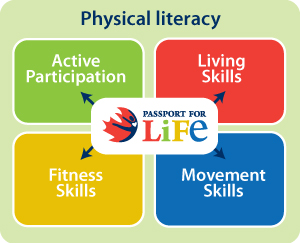Passport for Life supports the awareness, assessment, development and advancement of physical literacy among students and teachers. The four components of physical literacy that the Passport assesses are Active Participation, Living Skills, Fitness Skills and Movement Skills.

For the Active Participation and Living Skills assessments, students will complete online questionnaires. For the Fitness Skills and Movement Skills assessments, students will participate in fitness and movement tasks that the teacher will administer during physical education classes.
Passport for Life is...
- an assessment of physical literacy for improving student learning,
- a reflection of each student’s physical literacy,
- a tool that can be used for goal setting,
- a set of standards for physical literacy that promote learning and positive attitudes, and
- a resource created through an extensive development process including fundamental exercise science, research, evaluation and consultation.
Passport for Life is not...
- an evaluation (report card mark),
- a comprehensive (entire picture) assessment of physical literacy, or
- a physical literacy “award” program.
Important Note: Passport for Life assessment results are NOT to be used as a report card grade. The individual student results are formative and designed to support the improvement of one's physical literacy.
Online Platform
Passport for Life uses an online platform to input and house student data for each component (Active Participation, Living Skills, Fitness Skills and Movement Skills).
Each student will:
- complete motivating and inclusive assessments
- receive a Passport reporting individual data on each completed assessment that includes suggestions about how to improve their physical literacy.
Teachers will use Passport for Life’s online platform to:
- input and manage the data for each student and class in the program,
- connect to the health and physical education programs of study in their jurisdiction, and
- access a comprehensive Teacher's Guide that includes:
- tools, guidelines, and instructional strategies for completing the assessments;
- guides to help interpret and use the results; and
- ideas and resources to provide individualized attention and information to help students set goals and work towards continued improvement of physical literacy.
